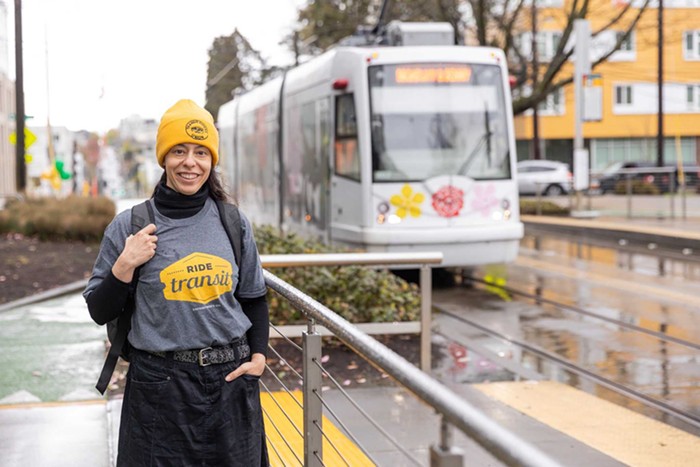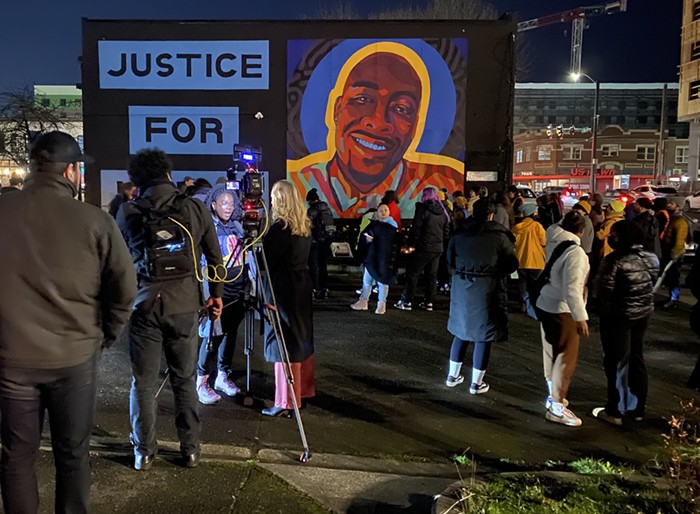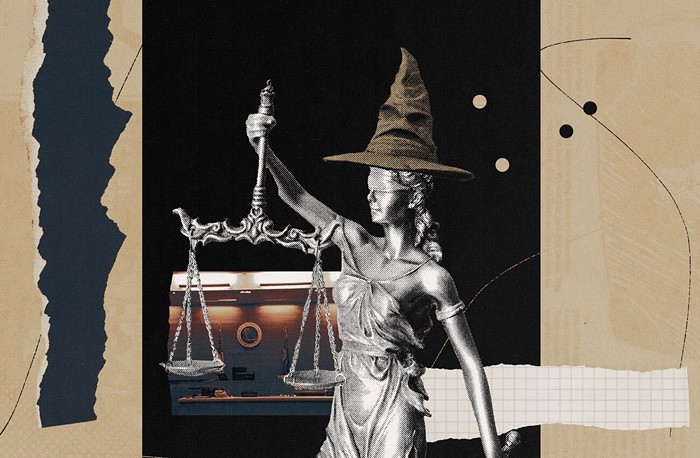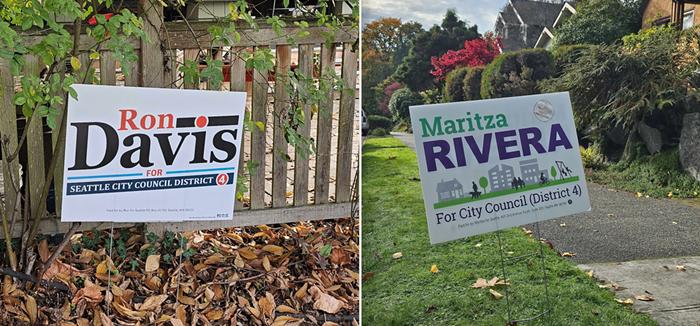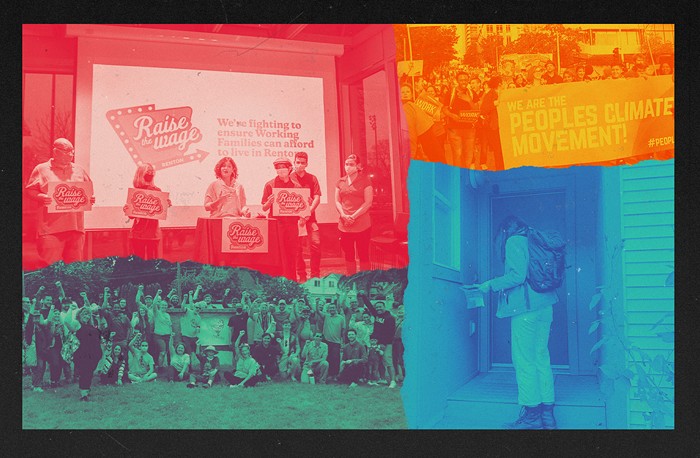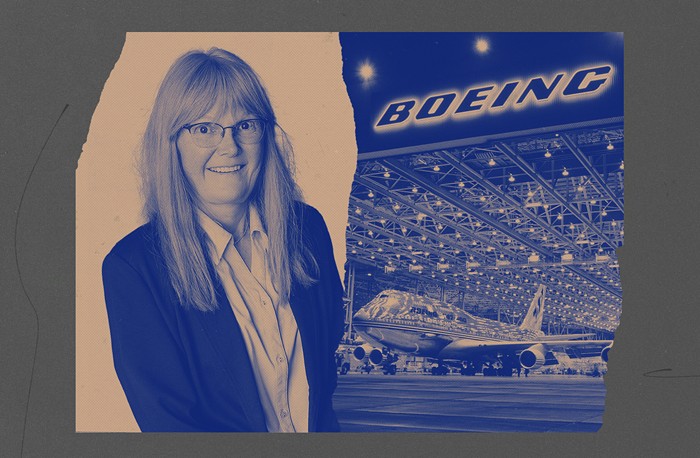Conspicuously absent from the shelves in their office, however, is a binder with "Seattle" written on the spine.
Grindline is one of the top skatepark-design companies in the world. Skaters adore the company's designs and craftsmanship, interviews with the Grindline crew fill skate magazines, and amateur skatepark reviewers praise Grindline's parks on their websites. Working for the company is many a local skaters' dream job. City planners give Grindline the thumbs up, and towns lucky enough to have a Grindline skatepark boast about them. The local company has received construction and industry awards, like one from the Washington Aggregates & Concrete Association, and two from the Skatepark Association of the USA, for excellence in both design and construction.
The one entity that hasn't joined the Grindline lovefest is the City of Seattle. The local skatepark heroes at Grindline have been virtually shut out of working in their own hometown--if you live in this city and don't skate, you likely haven't even heard of them, despite their international reputation. It would be as if Sub Pop's records weren't carried in local record stores, or Microsoft products weren't available in Seattle.
Skaters in Seattle can use their boards to get around town, of course. But like most municipalities our city frowns on skateboard tricks being performed on public property--benches, ledges, or planters. In Seattle, for example, it's illegal to skateboard in Westlake Plaza. So if skateboarders want to have fun and try athletic, often gravity-defying tricks--kickflips, grinds, ollies--they have to hit a skatepark.
Skateparks themselves come in all shapes and sizes, from tiny courses featuring one or two skate elements, like a quarter pipe--a big curved ramp--or a low rail for skaters to skid their wheels across. Bigger parks, especially those over 10,000 square feet, combine pipes and other "street" features with bowls: Think of an empty concrete swimming pool where skaters can zoom in circles on the banked sides, or leap up on the edge, twist around, and plunge back into the deep end. Grindline and other skatepark designers are constantly experimenting and trying new features.
Why isn't Seattle a showcase for Grindline parks? It's not the fault of the company. Owner Mark Hubbard got his start in the skatepark-design business when he was a young local skater. He and his friends lobbied the city to build public skate facilities, and when city officials wouldn't listen they resorted to building their own guerilla spaces. Grindline general manager Chris Hildebrand was instrumental in building the beloved Ballard Bowl, a project he had to wrestle with the city to accomplish, as a volunteer. Years later, there's still no one strongly advocating for skateparks from within the city. "There's not a single identified person in the parks department who skaters feel like they can trust," Hildebrand says.
•••
Unlike other cities in the Northwest, Seattle has been reluctant to acknowledge its vast skateboarder population. There are plenty of places to skate in the region, many of them built by--you guessed it--Grindline. But you'll have to leave town to see their parks. Bainbridge Island boasts one of Grindline's first parks, and Orcas Island has one of their best. Spokane and Sumner each have big Grindline parks, Arlington's Grindline park just opened, and Kent is embarking on its third skatepark project--a 15,000 square foot space that's slated to break ground this summer. Tiny Milton, home to 6,000 people, has a skatepark with a square footage nearly twice the size of its population.
But Seattle, despite a huge number of skateboarders--it is estimated that there are almost 20,000 skateboarders in town--and after a decade of work by skateboarding activists, is losing skateparks, not building them. Of the two city-sanctioned places to skate in town (the Ballard Bowl and SeaSk8 near Seattle Center), one is currently being demolished and the other will be torn down soon to make way for a new Gates Foundation headquarters. The city promises it will eventually replace both parks, and Seattle may get a third skatepark in Lower Woodland Park (a project that is still in the early planning stages). Even if all three skateparks are eventually built, it still won't be nearly enough to serve the city's skaters.
"If you count the future Ballard Bowl, SeaSk8, and Lower Woodland Park, we still will have less square footage in skateparks than Orcas Island," says Matthew Lee Johnston, co-chair of the city's Skatepark Advisory Committee, and a member of the Puget Sound Skateboarding Association (PSSA). Meanwhile, there are approximately 20,000 soccer players in town, too. They've got 70 fields in the city to play on.
Some dream of a more skateable Seattle. Skaters fantasize about a world-class park or two, with smaller satellite neighborhood parks. A parents' skatepark advocacy group has drafted a six-year plan for implementing a similar idea: four large "sector" skateparks, eight urban village skateparks, and 16 smaller neighborhood spots. Others imagine a supplementary network of "skate dots" scattered throughout the city, a sort of skateable trail with mini ramps, rails, and pipes, plus "skateable elements"--hard concrete planters, or benches topped by marble where skaters are encouraged to play without much risk of causing damage--around town. It's a vision within reach if the city would embrace it--and Grindline could build it.
•••
Grindline's founder Mark "Monk" Hubbard was born and raised in Seattle, where he still lives with his young family. In the late '80s he was building backyard ramps with friends, like other skateboarders up and down the West Coast. During high school Hubbard worked for a pool construction company, where he picked up tricks that would later enhance his skatebowl construction techniques.
In the early '90s, Hubbard and his buddies were tiring of basic ramps. They upped the ante by renting an old West Seattle church and turning it into a skatepark. "They turned the whole church into a half pipe," says Hildebrand. The absentee landlord eventually found out what his tenants were up to and "flipped out."
After the church skatepark died--and after some Seattle skaters had submitted a skatepark proposal to the city, which garnered no response--West Seattle's skaters, AKA the "Westside Warriors," moved on to Plan B. In short, in late 1991 the guys "found a spot under a bridge in West Seattle and dug a bowl out," Hildebrand says. For months Hubbard and his buddies covertly excavated dirt and quietly hauled in bags of concrete to a space under Admiral Way, where it skirts through the wooded and secluded Schmitz Park. The guerilla crew even went so far as to consult with a city bridge-maintenance supervisor to make sure the bowl wouldn't screw up the bridge's supports. He told them the bowl wouldn't be a problem, and added that he thought the idea was cool--then he warned them to check with the parks department.
Likely presuming that the parks department would squash the project, the guys went ahead and started cementing the makeshift pool without asking for permission. A neighbor called the cops, and officers arrived, guns drawn.
"That project was a bust," Hildebrand says sarcastically.
A newspaper report from the time of the bust notes the skaters' frustration with the city--complaints that skaters are still making today. "Skateboard fans here are right back where they started: no public facilities for their sport," a Seattle Times reporter wrote in March 1992. "Why does everyone else have something?" a skater named Scott Smiley told the reporter. "Seems like there's enough baseball parks and golf courses around. But nothing for skaters."
The Schmitz Park site was filled in (though if you go to the site and look closely, you can still see the bowl's outline), but news coverage of the bust led to the nascent skatepark builders' first semi-official project, the West Seattle bowl. A West Seattle homeowner got in touch with the guys, Hildebrand told me, sitting at his tall, homemade wood desk. "He was like, you can build that bowl in my backyard," Hildebrand says. The offer dumbfounded the skaters--who, at that point, were a group of friends interested in sculpting a bowl, not a licensed and bonded construction company. The private, largely hidden skatepark was "the first concrete bowl built in Washington," according to Hildebrand. It was also a big hit until the house was sold.
While Hildebrand is familiar with the Grindline lore, he's a later arrival on the Seattle skateboarding scene. Hildebrand--a laid-back guy whose shock of sandy-blond hair and bright blue eyes contrasts with Hubbard's cropped dark hair and matching stubble--landed in Seattle in 1999 with his wife. He got a baptism of fire in local skatepark construction and Seattle's famous love of process when he joined the volunteer effort to build the Ballard Bowl back in 2001. It was Hildebrand's drawings for the bowl that the Seattle Parks Department approved after two years of back and forth with skateboard activists. Even after the city gave the green light to build the bowl, the skaters ran into problems. "Anytime anyone would complain, [the city] threatened to shut the project down," Hildebrand told The Stranger back in 2001. "They kept trying to trip us up every chance they got." It was Hildebrand's hard work on the project, combined with his professional background in construction management, that landed him the dream job at Grindline.
•••
Grindline hasn't strayed far from its West Seattle roots. Hubbard and his crew set up shop in a house not far from their original bowl, tucked behind a tall hedge on a quiet residential street. The Hubbard family lives upstairs, while the design and build company--incorporated in 2002 and pulling in $2 million a year as of 2004--operates out of a finished basement crammed with rolled-up skatepark blueprints. At any given time, though, the company's crew is in some other city actually building a park.
Hildebrand oversees the office, and concentrates on sales. Hubbard takes over on the ground--he's often on the road, at one project after another--getting sites ready, overseeing construction, and making sure Grindline's parks are sculpted concrete masterpieces. There's a crew of over 20 carefully chosen designers and builders, all of whom skate, and most of whom got their start crafting their own mini skateparks in their backyards.
"They're not builders," Hildebrand says. "They're artists, really."
After the company comes up with an initial design for a skatepark--based on their expertise, community input, and the terrain--it's not unusual for modifications to take place during construction, often to include experimental features the guys are itching to attempt. The crew is adept at adjusting the geometry of jumps and bowls, discovering problem spots by skating it, and tweaking the park. "Sometimes you put something in and then realize you need more or less speed and you might have to change something," says Hildebrand. "Some things don't work and some do. We are always trying new things because that keeps it interesting for us. This is our lives, to build, but we need to progress."
Seattle's skaters would love the city to tap into Grindline's passion and talent. Why doesn't the city do it? Skaters say there is virtual red tape that all but prohibits amazing skateparks in the city, the kind that Grindline is known to build when they have the chance. But the city's parks department says their hands are tied by state law.
But first, skaters say the city has simply been slow to embark on new skatepark projects. No new skateparks has meant no chance for Grindline to roll up its sleeves and get to work. Though there has been a "Skateboard Park Policy" on file at Seattle Parks and Recreation since August 2003--it "recognizes skateboarding as a healthy and popular recreational activity and a legitimate use to be accommodated in the parks system"--new skateparks have yet to grace Seattle's landscape. "We realize we're behind the curve in providing places for skateboarders, and we're trying to get caught up," says parks' Susan Golub, who staffs the Skatepark Advisory Committee. The proposal to build a park at Lower Woodland is part of that effort.
The other thing keeping Seattle from becoming a Grindline showcase: The city adheres to state bidding laws that happen to inadvertently squash Grindline's creative skatepark philosophy. The best way to employ Grindline is with a design-build contract, so they have full control over the finished product. "We don't want our reputation to drop down because of someone else's lack of [design] talent," Hildebrand explains. On the flip side, they want to construct their design so they can fine-tune it on the ground.
But state law prohibits design-build contracts on projects that cost less than $10 million. With local skateparks usually hovering around the half-million-dollar mark, their design and construction are put out for separate bids--and different companies must be hired on each part. Though Grindline can still get in on a piece of each park, like the Ballard or SeaSk8 replacements, skaters would rather the city find a way to allow the company to do what it does best, which means giving them breathing room to design and build a park. "Public art seems to get away with it," Johnston says wryly.
"I looked into this to see if we could get around it," says Golub. She understands the skatepark advocates' push for a design-build scenario on new parks, but says, "The only time we've been able to get around it is for unique exhibits for the zoo." (And no, a skatepark can't qualify as an arts installation, because it's clearly a recreational facility). Unlike a zoo exhibit, she says, skateparks have become so popular, the city "can't make the argument that you need a unique builder to build it. You'll have other concrete contractors say I can do that, and I have done it in these places."
Skaters, however, point out that other Washington cities and towns have tapped Grindline to design and build a park, by thinking outside the box. Some municipalities have simply split projects into two parts, but let Grindline bid on both. Others hire them to design, then put the design out to bid--and Grindline bids on it. That wouldn't work in Seattle, Golub says. "We just are so scrutinized that we couldn't do that," she says.
Hildebrand acknowledges the state's design-build law, but thinks Seattle could do more to work around its parameters. "Cities either choose to overcome the problem, or they choose to use it as an excuse," he says. "Either you find a way, or you don't. It's not hard. If you're committed to getting it done, you'll get it done." Instead, Seattle has built a reputation as difficult to work with on skateparks, Hildebrand says, which has "alienated the entire skatepark industry."
While Seattle's process and the state law essentially prevent Grindline from building signature parks in its hometown, suburban cities and towns find a way to "get it done." Perry Brooks, the parks and open space manager in Kent, has been working with Grindline on a new skatepark--slated to be part of a million-dollar park on Kent's east hill--for three years (Brooks originally tracked down Hildebrand when he was working on the Ballard Bowl). Kent already has two other skateparks--yep, they're about to have three, in a city about a sixth of the size of Seattle--designed by Perkiss Rose, a former California landscape-design company that jumped onto the skatepark bandwagon in the 1990s. Even though Grindline's Kent park isn't even built yet, Brooks predicts that it is already the best of the three. "They're not skateboarders," Brooks says of Perkiss Rose. Grindline's skatepark in Kent will be nearly 17,000 square feet, featuring a figure eight and a full pipe. Brooks is expecting on-the-fly modifications. "That's one reason we picked Grindline, because they are a design-build firm," says Brooks, who skateboarded as a kid, sometimes in his parents' empty pool in Phoenix. "It's so difficult to hire a general contractor to interpret a skatepark plan when there's a great need for reinterpretation of the plans on site. It absolutely is an art form."
In Milton, Public Works Director Marlo DeRosia helped with the final push to build a skatepark, after skaters in the late '90s approached the city with a petition and $2,000 they had raised through garage sales and car washes. The city was into the idea at the time, but it didn't happen until DeRosia came on board in 2002 and shepherded the project through the small town's government. The project got going after much fundraising and design consultation with Grindline--the community's kids wanted basic street-skating elements, mimicking what they already had to skate on around town, but Grindline pushed for a bowl to challenge the towns' skaters. Grindline was "definitely outside of my comfort zone," DeRosia laughs. "To get a unique, high-quality, skateable product, I needed to let them do their work."
Grindline finished the Milton skatepark in 2004.
"It's the gem of the community," DeRosia says. It's even a place "for people to go who aren't skaters." DeRosia now finds herself coordinating skate competitions, which draw skaters and promoters from around Washington and the nation. In one competition last summer, a local kid was spotted by scouts from Vans and picked up by the company for sponsorship.
•••
So what's Seattle's problem? Why hasn't our city followed in Milton and Kent's footsteps? Skateparks are unbelievably popular. Encouraging people to go skate in their neighborhood park instead of sitting at home in front of the TV is a great way to fight obesity. Skateparks can even help curb crime, by putting tons of eyes in the parks where they're built--a tactic Seattle already understands, as evidenced by a propensity to install heavily used dog parks or p-patches on bits of land that could use a dose of positive activity.
The parks aren't prohibitively expensive. Most skateparks cost between $20 and $30 a square foot--or about $250,000 for a decent-sized 10,000 square foot park--though cities usually opt to add seating and landscaping around them to integrate the concrete structure into the neighborhood. Washington State's Wildlife and Recreation Program even offers cities grants to build things like skateparks. Kent got a nearly $550,000 grant to build their newest park. "The City of Seattle, they could do really well getting a grant from the state," Brooks says. (Indeed, the city sought a grant for Lower Woodland Park, and received $300,000.)
With nearly 20,000 skaters in Seattle alone (it's estimated that there are about 100,000 in the Puget Sound region), current skate facilities in Seattle are inadequate. Both the Ballard Bowl and SeaSk8 are being replaced with small parks (in SeaSk8's case, there's funding to rebuild a 8,800 square foot park). Lower Woodland Park, if it's fully realized, could be up to 24,000 square feet. Even so, as Johnston pointed out, Seattle will still have less combined space than in Orcas Island's single park.
Golub says the city is working to add more skateparks. "We want to get one in each quadrant of the city," she says. "We've got to get something into the South part of the city. We're trying to find a location in West Seattle, then we'll try to find money."
Hildebrand sees lots of space to tuck even more skate facilities into the urban landscape. "There are plenty of public places that could easily be used. We wouldn't have to change the entire city. Vancouver is working on designs to integrate parks in every neighborhood," he says. "We could have a few places that cost $15,000 each. A small one could be a concrete bench with marble on the top and that'd be cheap and it would function as a bench and look good."
A 10,000 square foot neighborhood park can easily accommodate 25 people actively skating at the same time, Hildebrand says, with dozens of others perched on the edges waiting to jump in and take a turn. If you've stopped by Seattle's teeny existing parks--both less than 10,000 square feet--they're rarely empty during open hours. Even when school's in session you'll find adults getting in a few runs. Last Monday night at SeaSk8, nearly a dozen skaters squeezed every last bit of skate time out of the day, as the sun slipped below nearby Memorial Stadium. The skaters, mostly teenagers, swooped and floated along the park's shallow cement waves. It's not unrealistic to estimate that this park or Ballard's tiny bowl, when it was open, served at least 200 people a day, far more than a typical city tennis court or ball field serve in any given day. Even on a rainy day, skaters were ready with mops and towels to dry out the Ballard Bowl as soon as the weather cleared, so they could squeeze in some skating before the sky opened up again. The city's tennis courts, basketball courts, and ball fields are usually empty in the winter.
Other existing parks are plagued by crime. Installing a skatepark in the corner of Capitol Hill's big Cal Anderson Park, for example, could curb neighbors' concerns that the space will turn into a homeless encampment when it reopens this summer after two years of renovations. The park's new fountain, while interesting to look at, certainly won't deter crime. Southeast Seattle's Othello Park could potentially be reclaimed from gangs by giving the community a reason to use the space all day long.
The ability of a full, active park to deter crime and benefit the community is helping drive a private-sector skatepark project in the South Park neighborhood. Sea Mar Community Health Center, a nonprofit organization, has an extra slice of property it is handing over to the community. Neighborhood activists leapt at the chance to use the land--a 14,000 square foot triangular plot on Cloverdale Avenue, just east of a Highway 99 on-ramp--to create something useful for the area's families. A skatepark was an obvious choice, fitting with Sea Mar's mission to foster "nonviolence, social health, and community building."
"We called Grindline," says Mark Johnson, a South Park resident, landscape architect, and "born again skater" who's helping lead the project. Grindline, given its first real opportunity to build a park in Seattle, jumped at the chance. "We're continuing to pinch ourselves," Johnson says over lunch near his Pioneer Square office. He pulls out a rough sketch of the park, dubbed the River City Skate Park. "It will mostly be pipes, and there will be a pool. There will be rails," Johnson says.
"Grindline totally stepped up," says Ian Klein, another volunteer working on the South Seattle project. "They are donating a quarter million to construction of this project."
Grindline is not only doing the design and overseeing construction, but the space, when its finished in 2006, will serve as the headquarters for Grindline. Their office and design studio will be adjacent to the bowl. They hope to push their creative boundaries, and integrate the building into the design so that it's skateable. Grindline employees will theoretically be able to skate from their offices, out the door, and into the skatepark.
Hildebrand is excited about River City, though sitting in Grindline's West Seattle office, he's hesitant to talk about the plans. The project is almost too good to be true, and no one wants to jinx it. His attitude is easy to understand, given what Grindline and the rest of the city's skaters have put up with from the city for over a decade. "Seattle is just old fashioned, and not truly responding to the needs of the people," Hildebrand says. "It's ridiculous. Seattle parks are paralyzed by their own bureaucracy."
•••
Even if the city is making incremental progress--rebuilding the Ballard park and SeaSk8, looking at Lower Woodland Park--Johnston, at the PSSA, points out that as of this moment, "No skateparks have been built, they've only been torn down."
Johnston and his cohorts at the PSSA, plus parent advocates, members of the advisory committee, and the city's skaters will keep a fire under the city until they get some action. But sadly, Grindline's guys have essentially given up. If the city comes to them with a funded project and asks for bidders--as is the case in Ballard--they'll play ball. But they're not going to keep pestering the city to be more skate friendly. They're too busy building parks in other cities. "They failed us and we are giving up on them and looking at other places," Hildebrand says. "We should at least have 10 parks around the city by now. If the city had been letting us build parks, it would be a hot skate town."
